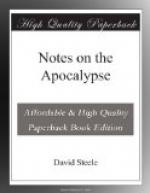15. And the kings of the earth, and the great men, and the rich men, and the chief captains, and the mighty men, and every bond-man, and every free-man, hid themselves in the dens, and in the rocks of the mountains:
16. And said to the mountains and rocks, Fall on us, and hide us from the face of him that sitteth on the throne, and from the wrath of the Lamb:
17. For the great day of his wrath is come, and who shall be able to stand?
Vs. 12-17.—The sixth seal is opened, like the rest, by the hand of the Mediator, and here “his right hand teacheth terrible things.” “By terrible things in righteousness wilt thou answer us, O God of our salvation.” (Ps. lxv. 5.) The awful scene disclosed would seem to be a beginning of answer to the importunate cry of the “souls under the altar,” as in the foregoing vision.
Many expositors since the time of Cyprian in the third century, have understood this seal as disclosing the scene of the last judgment. No doubt the symbols here employed are suited to that event; but the series of seals, trumpets and vials, not to speak of events still more remote, wholly precludes such an interpretation. All the symbols under the sixth seal betoken revolution. Such is their established and well known import in other parts of Scripture.
The “earthquake” is more than a shaking of the earth. It is a concussion of the heavens also. As Haggai is interpreted by Paul, we learn the civil and ecclesiastical change of the Jewish polity by the “shaking of the heavens and the earth.” (Hag. ii. 6; Heb. xii. 26, 27.) The day of final judgment is so often referred to as certain, that no special prediction was needed to assure us of that event. Indeed, the description of the day of judgment is commonly employed by the prophets to represent revolutions among the nations. So it is in reference to the overthrow of Babylon, (Is. xiii. 13.)—of Egypt, (Ezek. xxxii. 7, 8,) of Jerusalem, (Matt. xxiv. 7, 29.) The “sun, moon and stars” are emblems of civil officers, supreme and subordinate, as well as of military commanders. Their consternation and despair, now that they are cast down from their exalted position, as heavenly luminaries darkened and hurled from their orbits, betray their apprehension of deserved and inevitable wrath. Indeed we may view the last three verses of this chapter, as exegetical or explanatory of the preceding three. The whole frame of imperial power underwent a change which is commonly called a revolution. And the grandeur of the complex symbols, borrowed from the closing scene of time, was never more appropriately employed by the Spirit of prophecy, than in the present instance, to portray the total overthrow of pagan power, idolatry and tyranny. The most conspicuous instrument in the Mediator’s hand by which this great revolution was effected, is well known in history as “Constantine the Great.” The great lights of the heathen world, the powers




